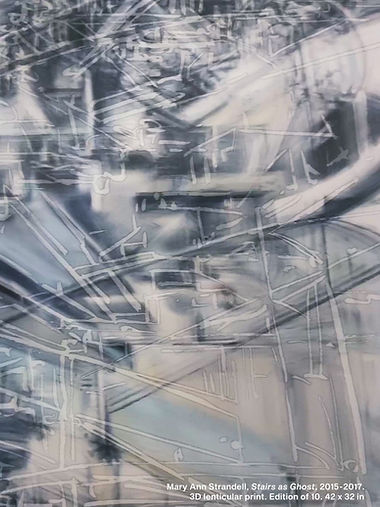Mary Ann Strandell
Floating Steps
Presented by J. Yuan & Associates LLC
From architectural structures, nature subjects, to objects circulated along ancient and modern trade routes, Mary Ann Strandell’s work reveals the fluid and mediated configuration of the observed reality with a certain level of fidelity to appearance. The liminal presence of her painted environs, both the interiors and cityscapes, connote a fractured space-time continuum embodied by the pictorial plane. By turning paintings and drawings into 3D lenticular media, Strandell disassembles spatial rendering to a cumulation of transitory imageries, interweaving multiple layers of visual narrative. Against the backdrop of quarantine as a new normal, experiencing these works possesses silent omnipotence. Whether to step towards the authentic realm or plunge into the simulated imagination is a slippery conundrum for the audience to solve in the virtual exhibition.
Artist Talk | Mary Ann Strandell on Floating Steps (2'48")
Curator Walkthrough | Mary Ann Strandell: Floating Steps , by Yinxue (Sheryl) Wu, the curator of the exhibition (7')
Strandell began treating the all-glass, swirly staircase as a significant subject around 2008. The initial work of the series, Cloud (2011), is based on a series of photographs she took of the iconic staircase in the Apple Store in Chelsea, New York, near her studio. With years of experiment, she renders the subject with delicacy and sophistication across media. For the artist, the ethereal staircase in the Apple Store stands for “a place of no place.” Virtually suspended in the air, it functions as a passage that leads the public to the very hub of advanced personal technology solutions, upon which our modern life and culture exist.
Throughout art history, the staircase has always been a metaphor of dislocation and mediated space. Strandell enriches such connotations by comparing the architecture structure to the cloud—as the atmospheric form and as the destination of digital storage. Her work visualizes the interflow and substitution between physical space and cyberspace that we are all inevitably experiencing during the quarantine.

Mary Ann Strandell
Transit Space/Unesco Paris I, diptych, 2019
3D lenticular media, 42 x 44 in
Often walking between her studio in Chelsea and the ferry terminal, Strandell traces the evolution of Hudson Yards construction since its inception, which has lasted seven years so far. Similarly, she witnessed 56 Leonard—the tallest structure in Tribeca designed by Herzog & de Meuron—going through a ten-year construction with a four-year pause in-between. She finds construction sites reveal the complexity in a way that the finished buildings don’t; they embody a sense of growth and hope while simultaneously appear fragile and dissolving.
“The descriptive, discursive nature of these works is less about the actual places I have rendered, and more about considerations of time and the theatre of change,” Strandell writes. Her depiction of the concrete skeletons in New York speaks to the volatility and prosperity that a metropolis simultaneously promises. In this pandemic era, her paintings coincide with the pictures of empty cityscapes filling news feeds. Yet with vibrant colors and solid strokes, they stimulate romantic and nostalgic reveries rather than apocalyptic visions.
Strandell has employed lenticular prints into her practice since the early 2000s. Fascinated by the polyglot quality of the medium, she gradually evolves her style from pure colors and geographic to layered visual narratives and spatial ambiguities. The disparate imageries—mid-century designs, 15th-century Chinese vases, 18th-century Meissen figurines and chinoiseries, birds, and fruit—seem irrelevant to each other at first glance. Yet together, their collision conveys an underlying logic of intersectionality and interchange in the process of globalization. These lenticular prints also function as part of Strandell’s installation works, in which she mounts the prints on a hand-painted, large ink drawing of a period room applied directly to the wall.













